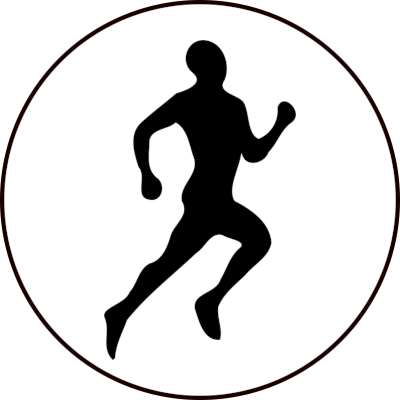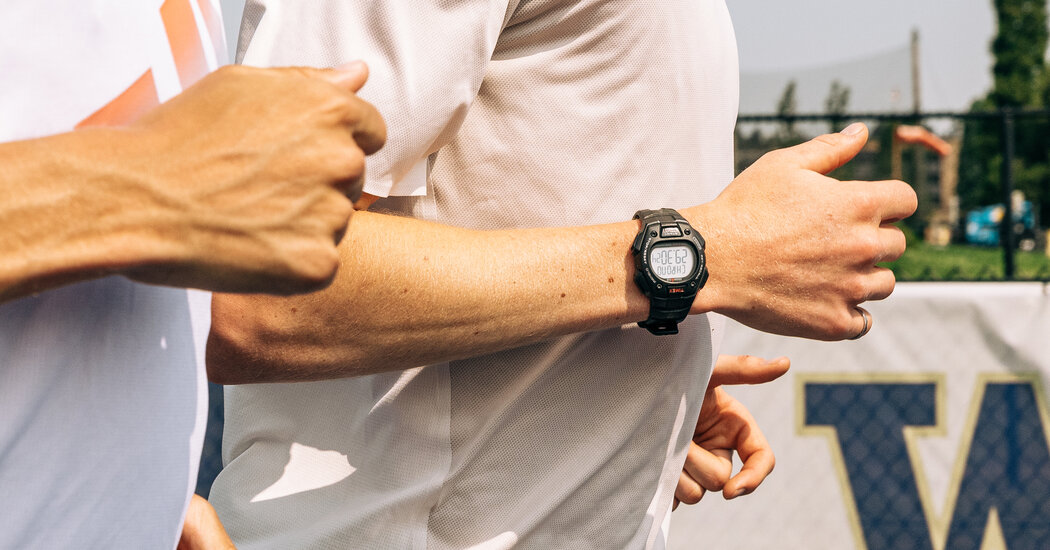"[Heather MacLean, an Olympic 1,500-meter runner] realized her watch was draining the fun from her runs. It was especially apparent to her during a low-key stretch when she was simply trying to build fitness.
I hated that every run I went on, I felt like I had to check my pace and my distance and whatever else,” she said. “So I just decided that I was going to lay off it for a while and switch to a regular watch.”
She never went back. MacLean, 28, who now wears an Armitron Dragonfly that she said she picked up for $10 at Walmart, acknowledged that there were certain workouts when a GPS watch would come in handy, like when she did a tempo run by herself. (Tempo runs are faster than easy jogs, and frequently run at a prescribed pace.) But Mark Coogan, her coach, has long prioritized effort over pace, and MacLean logs her training in minutes rather than in miles.
“I know I’m at the elite level now, so not everything is going to be joyful,” MacLean said. “But when there are things that bring me a lot of joy, I’m going to invest in them. And one of those things is the ability to avoid focusing on my pace during my runs.”
Without the pressure of feeling as if she needs to account for every mile — or, perish the thought, post her workouts for public inspection on Strava, the exercise-tracking platform — MacLean has also gotten better about listening to her body. She has no qualms about bailing on an extra workout if she is feeling beat.
“And I’ll tell Mark that I’m going for a walk instead,” MacLean said. “And he’s like, ‘OK!’”



Whatever they’re experiencing, I have the opposite. It’s the numbers and the data that keeps me interested and focused. It’s learning to align what my body is telling me with what my watch is telling me.
If I lost access to smart watches, I’d probably not stay active
100% same for me. I’m a data geek. I don’t even need to actually be using the data to train by to get enjoyment just out of seeing it there. Seeing my averages change, or my monthly time grow, or just looking at the relationship between pace, cadence, and stride length. That’s part of the fun of it all!
Same, it was getting a Garmin that got me into tracking steps, fitness etc. I didn’t even run initially. I walked for 18 months first. Slowly progressing to jogging bits of it, then more until eventually I was jogging the whole circuit.
I’m no elite runner. The first kilometer of my circuit has a 130m ascent of staircase up an escarpment. It’s brutal and I love conquering it. But it stifles any hope of breaking time records.
Ever thought about letting that staircase be the stat end? That way you can also squeeze in a rest every circuit if you feel like it.
I’d just … not do it sometimes. I’d justify it with “too tired today” and “Don’t have enough time for Jacob’s Ladder today”. Having it when I’m fresh takes that excuse away.
It’s also kinda on the way out of the CBD and into a big park. It would be sort-of doubling back away from the office. I could make it work, but the beautiful park is like a reward for doing the climb. Having the return to the office be my reward for doing it wouldn’t quite have the same incentive.
Ahh, that makes sense. Whatever works for you.
Back in school our PE teacher would make us run up the staircase and then back down, incrementally increasing the floors we’d have to climb in one go. It was torture, and I remember it bitterly, even though it did loads to improve my general health and breath control.
I’m not a runner, but I lift and I’m very goal and data oriented much like yourself. I love to see objective measurements of improvement in what my body is capable of. I love track the sheer tonnage that I pick up off my basement floor then put right back down on my basement floor. I live to look back at my numbers from a year ago and see the difference and I think I really would lose a lot of my motivation if I couldn’t.
Same, I want more and better accuracy. I just ditched an Apple Watch Ultra for a new Garmin unit because it’s just that much better for my needs.
Which one did you choose?
Epix Gen 2 Pro
Absolutely. I just crossed 500mi this year, for the first time. I’m really excited by hitting that mark (I know, not a big deal to most runners), and will be seeing how high I can go without injury by year end.
Anyone else ever just feel like every topic these days has to have pro and con article out there for people to latch onto? I’m sure it’s only getting worse with AI, but there’s so many of these that just seem to exist to be sticks to get people to discuss things.
I guess I’m the guilty party. :) I posted the article because I thought it was thought provoking enough to engender discussion – something I like if it’s civil and mostly intelligent. I didn’t think everyone would agree with the athletes quoted or that they should or shouldn’t.
I feel like most of these could be explained by people who have lost their love and need something to blame.
There’s no way metrics is hampering them.
I can easily think of times I likely should have rested or slowed down but wanted to keep a number high.
For me, metrics are a net positive, but I’ve often done counterproductive things because of them.
Maybe I use my watch differently, but I use my watch to set the pace I should run at, and then it ensures I keep myself there without going too fast!
Yeah that’s definitely it for me. Far more often I look at my watch and realise I’m going too fast for the type of run I want to do, and slow down, than the opposite.
Last year I was running a marathon with a target time that perfectly matched one of the pacers, so I stuck to her. But she was going about 10 seconds per k faster than the target pace for the first two thirds or so. If I hadn’t had my watch to know that, when I eventually couldn’t keep up with her after about 26 k I would have felt utterly defeated. As it was I knew I still had a fair bit of wiggle room, and I ended up coming in just under my target time.
Though the opposite does happen too on occasion. Particularly in those faster tempo runs.
I use pre-programmed pace times for my runs, and my watch complains at me when I go above or below that bracket.
Interesting. I’ve seen the option for that on mine but I’ve never used it. How well does it work? I don’t really even trust mine to tell me my “current” pace, preferring to rely on lap average and automatically lapping each kilometre. Does the pace guide work well?
The other obvious worry is hills. If I’ve got a target pace in training, I usually am not thinking about hills in that, and I’d be happy to slow down while ascending them, and I’m probably not going to quite make up the difference on the downhill. Is that not a problem you’ve run into?
So, I used TrainAsOne, which builds a dynamic plan that adjusts to your fitness levels etc.
And when it generates a workout, it exports that to my Garmin. So then when I run, the Garmin has a pace range, and it shows my average pace for that leg, updated in real time, in a nice little interface. Green when I’m within the pace band, red when I’m not.
Also, given that it only cares about your average pace for the leg, it also takes in to account your previous runs and assumes you will run something similar in terms of gradient. It also adjusts for expected heat levels etc.
It will be wrong if you move to a location with a radically different gradient profile, but even then, once you’ve run it, it will take in to account the actual gradient and your pace, so you don’t get punished for running slower on gradients
Oh that’s very interesting to hear. I’ve just signed up for TAO yesterday and I’m excited to try it out.
I must say from what I’ve seen of it so far, it has some weird deficiencies, like the inability to tell it I want my Sunday run to be the longest one—or even that I definitely want a Sunday run at all. Guess I’ve just gotta learn to trust the AI’s wisdom? Seems to sorta go against the idea that it’s about flexibly reacting to your life.
Out of interest, do you have any particular fields it’s helpful to display when running a TAO workout?
On Coros watches, there’s “effort pace.” I think it’s very close to “gradient adjusted pace” on some other watches. Both give a pace number adjusted for the grade one is running up or down. On Coros, one can make workout targets using effort pace that adjust for hills.
Oh that’s interesting. I run with a Garmin watch, and it looks like Grade Adjusted Pace is something they only added as of the Forerunner X55 generation of watches. I have a Forerunner 935, so it’s not an option for me. But assuming it works well, that’s a potentially really useful field to have.
The downside of Garmin’s very obvious artificially-short lifespan on their devices by almost never providing software updates with new functionality.
Nobody is being hampered, the article was talking about joy.
deleted by creator
That’s in the company of others, most people playing solo keep tabs to see if they’re doing better or worse.
deleted by creator
I guess that’s the problem, people hold onto stuff that they no longer love expecting changes will make it better.
Dont you think maybe moving onto another interest where you can continue tracking the stats you love along with it? You CAN have both you know….
I absolutely understand the angle you guys are coming from, maybe look at something from a different perspective once in a while.
deleted by creator
That’s not the people the article was talking about?
deleted by creator